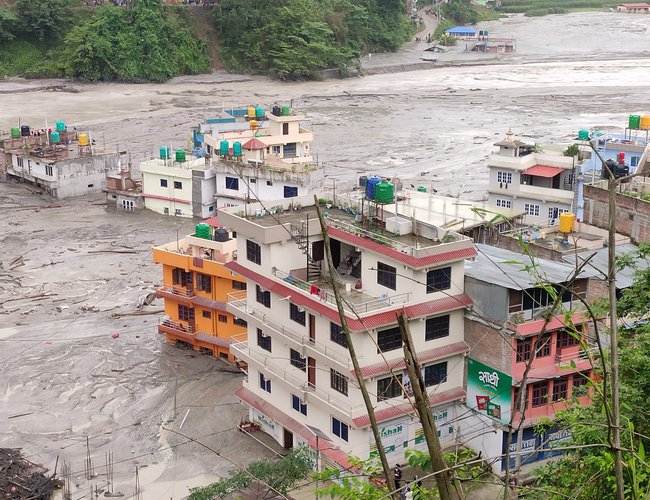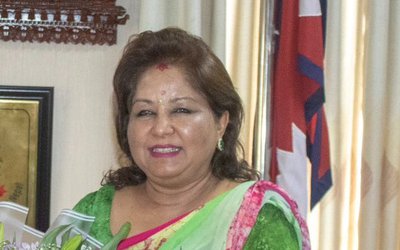
Low-income countries are at the greatest risk of suffering losses and damage as a result of climate change. The impacts of human induced climate change, such as floods, landslides, and glacial lake outburst floods, have wreaked havoc on these countries. These events have resulted in the loss of lives, displacement of communities, destruction of infrastructure, and economic setbacks.
A stark illustration of the vulnerability of low-income countries to climate change is evident in the Melamchi Water Supply Project here in Nepal. This ambitious endeavor, supported by the Asian Development Bank (ADB), sought to alleviate water scarcity in Kathmandu by redirecting water from the Melamchi River. However, heavy rainfall-induced landslides inflicted damage on the project's head works, halting progress and extending hardships for local residents, subsequently impeding productivity.
The Melamchi Water Supply Project is a vivid example of the risks of large-scale infrastructure projects in mountainous regions like Nepal, where human induced climate change-induced landslides are more prevalent, particularly during the monsoon season. The project was halted after its head works were damaged by a landslide caused by heavy rainfall. This incident has sparked criticism over the suitability of such projects in these regions, as well as the credibility of the Asian Development Bank (ADB), which was tasked with quality assurance, particularly on building safeguards.
The project has been ongoing for over 25 years and has cost over USD 800 million. Now, Nepal, one of the poorest countries in Asia, is being saddled with more loans to correct the damage and design flaws. This raises serious questions about who is responsible for these oversights.https://www.nytimes.com/2022/10/06/world/asia/nepal-water-melamchi.html
Did the ADB shirk its responsibility to assess the risks of climate change and landslides in Nepal before approving and during the long implementation period of the Melamchi Water Supply Project? If not, why not? If so, why were the risks not adequately addressed in the design of the project? https://www.adb.org/publications/learning-challenges-melamchi-water-supply-kathmandu
Was the project designed to withstand the force of a major landslide? If not, who is responsible for the design flaws in the project? If so, why was the project not able to withstand the force of the landslide?
Who is responsible for the cost of repairing the damage? Is the ADB responsible for any of the costs? Is Nepal responsible for all the costs? Or is some of the responsibility shared between the ADB and Nepal? https://www.worldbank.org/en/news/feature/2022/03/28/in-nepal-2-major-climate-disasters-in-a-single-year-highlight-the-need-to-build-resilience.
It is essential to recognize that this vulnerability is not limited to Nepal alone; many other developing countries like Burundi, Somalia, and Mozambique confront similarly elevated risks. While the least at risk are Luxembourg, Switzerland, and Ireland. The presence of cascading hazards such as landslides, avalanches, flash floods, and glacial lake outburst floods further exacerbates their susceptibility. Multihazard risk management strategies must be urgently adopted to address these challenges effectively.

Additionally, Women are disproportionately affected by loss and damage from climate change. This is due to their unequal access to resources, decision-making power, and mobility. They are also more likely to be responsible for care work, which makes them more vulnerable. Specific actions that can be taken to address gender vulnerability on loss and damage include ensuring that women have a voice in decision-making processes, meeting the specific needs of women, and supporting women-led organizations.
The economic toll of loss and damage in developing nations is projected to be staggering, with estimates ranging from USD 290 to 580 billion per year by 2030. This cost is expected to rise even further by 2050. Clearly, the inaction is too costly, necessitating immediate action to tackle climate change-related loss and damage. During COP28, global leaders must acknowledge the unequal impacts of climate change on low-income countries and make it a priority to address loss and damage. Crucial actions to prioritize include accelerating efforts to combat the climate crisis, creating a dedicated fund for loss and damage assistance, strengthening financial support with a focus on climate justice, and enhancing multihazard risk management strategies.https://www.worldbank.org/en/news/feature/2022/03/28/in-nepal-2-major-climate-disasters-in-a-single-year-highlight-the-need-to-build-resilience
During the upcoming COP28 in Dubai, UAE, global leaders must acknowledge the unequal impacts of climate change on low-income countries and make it a priority to address loss and damage. Crucial actions to prioritize include accelerating efforts to combat the climate crisis, creating a dedicated fund for loss and damage assistance, strengthening financial support with a focus on climate justice, and enhancing multihazard risk management strategies.
Rethinking development approaches in low-income countries is imperative, with an emphasis on sustainable and climate-smart infrastructure projects. Evaluating the suitability of mega projects in climate-vulnerable regions should be a crucial aspect of this approach.
The cost of inaction is too high, and the need for urgent action is primary. At COP28, world leaders must recognize the disproportionate impacts of climate change on low-income countries and prioritize action to address loss and damage. Key actions that should be prioritized include:
- Increased financial and technical support: Developed countries must fulfill their commitments to provide financial and technical support to developing countries to address loss and damage and enhance resilience.
- Strengthening multihazard risk management: Collaborative efforts are needed to develop and implement effective multihazard risk management strategies in vulnerable regions. This includes early warning systems, infrastructure resilience, and community-based adaptation measures.
- Climate justice and equity: The principles of climate justice and equity should guide decision-making at COP28. It is essential to recognize the disproportionate impacts of climate change on vulnerable communities and ensure their meaningful participation in decision-making processes.
- Rethinking development approaches: Sustainable and climate-smart infrastructure development approaches should be prioritized in low-income countries. The suitability of mega projects in climate-vulnerable regions should be reassessed.
By taking concerted action on loss and damage, promoting resilience, and fostering inclusive climate action, COP28 can significantly contribute to a more sustainable and climate-resilient future for low-income countries. The recent IPCC assessment report underscores the urgency of this endeavor, stressing the need for immediate action to prevent irreparable harm from climate change. As the largest annual climate conference, COP28 provides an opportune moment for global leaders, civil society, the private sector, and climate activists to unite in developing bold, innovative, and ambitious solutions to tackle the pressing human induced climate challenges faced by low-income countries
In conclusion, low-income countries are at the greatest risk of suffering losses and damage as a result of climate change. The impacts of climate change in these countries demand increased support, multihazard risk management, climate justice, and a reevaluation of development approaches. By addressing loss and damage and prioritizing resilience, COP28 can pave the way for a more sustainable and climate-resilient future for low-income countries.

Arup Rajouria
is an internationally recognized expert in climate change and natural resources management, with an impressive career at renowned organizations such as the former CEO of NTNC's CEO, UNDP, UN-Habitat, UNEP, and USAID. He obtained an MPA degree from Harvard
- Himalayan Meltdown: Threat Beyond Borders
- May 10, 2024
- Navigating The River of Doubts: The Evolving Dynamics Of India-Nepal Water Relations
- Jan 08, 2024
- A Cry From The Himalayas: Echoes Of Hope And Compromise At COP-28
- Dec 21, 2023
- Climate Crisis: Can world Leaders Rise to the Challenge ?
- Nov 17, 2023
- Conflict Diverts Attention: How the Hamas Israel Crisis Affects Climate Priorities At COP 28
- Oct 28, 2023
















